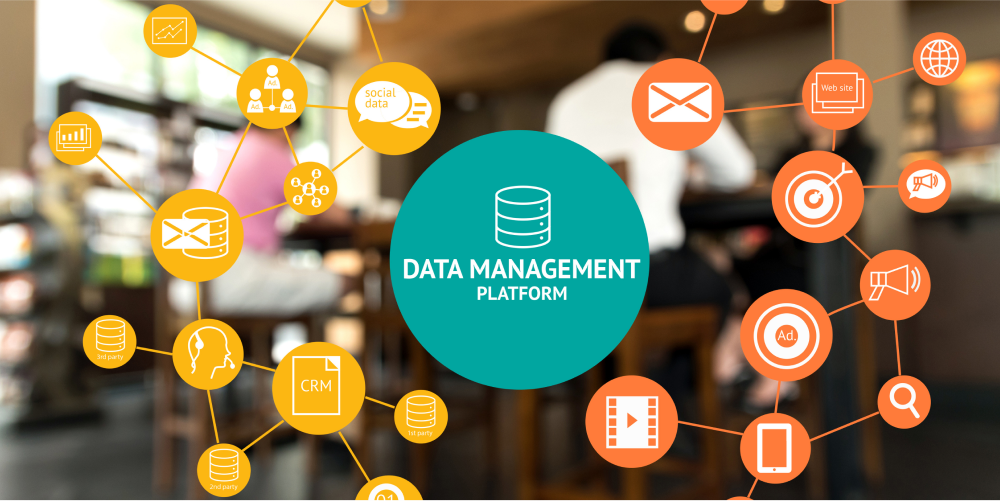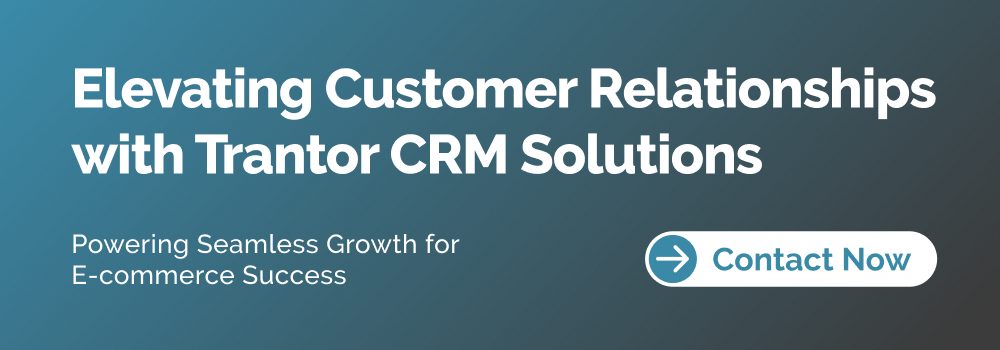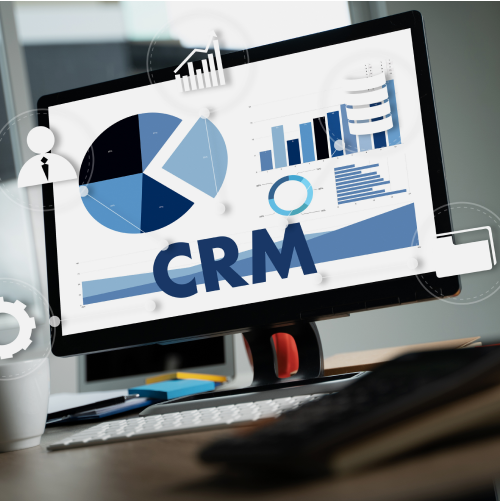Ecommerce Development, zBlog
How to Build a Powerful eCommerce CRM – The Complete Guide
trantorindia | Updated: January 19, 2024

Introduction
For fast-scaling eCommerce businesses, having 360-degree visibility into customer behavior and being able to effectively engage shoppers throughout their lifecycle is vital to continued growth. But without the right tools and systems centralizing all data in one place, bridging digital insights with impactful real-world actions becomes extremely difficult.
That’s where implementing a powerful and tailor-made CRM for eCommerce businesses enters the picture. An eCommerce-optimized CRM seamlessly consolidates all vital customer data across channels into one easily accessible interface. This equips teams to better track, serve, upsell, and retain valuable customers over time by transforming fragmented metrics into actionable insights.
In this comprehensive guide, we will:
- Explain the immense benefits a purpose-built eCommerce CRM delivers
- Overview must-have features your CRM platform requires
- Share tips for driving widespread organizational adoption
- Discuss how to select the ideal CRM tailored to your brand’s unique needs
- Convey why CRM underpins the entire customer experience, not just sales
Once integrated properly, an eCommerce CRM platform has the power to greatly strengthen loyalty, and lifetime value and allow providing tailored experiences that feel responsive and human at any scale.
Let’s dive in!
The Strategic Imperative of CRM for eCommerce

For modern direct-to-consumer (D2C) eCommerce businesses, customer data encompassing transaction history, product preferences, contact records, support issues, and digital body language is hugely important for nurturing relationships over time. However, allowing that data to languish across fragmented systems makes scaling personalization feel impossible.
This is where utilizing a tailored and custom CRM for eCommerce delivers immense advantages:
- 1. A Unified Customer Database
Consolidating every interaction, order, issue and contextual insight related to each client in one shareable system grants a holistic view of the customer lifecycle. This makes crucial data easily accessible to any stakeholder, no matter their department. - 2. Powerful Analytics & Segmentation
Analyzing aggregated data uncovers insights around client lifetime value, predictive churn indicators, campaign ROI plus nuanced shopping habits and technical preferences not visible in platform analytics alone. Advanced segmentation then allows targeting high-value groups with tailored offers using a full profile view other tools lack. - 3. Process Automation
Streamlining hundreds of previously tedious manual tasks across customer service, order processing, account management, and promotional messaging saves teams major time. Response rates simultaneously accelerate thanks to preset triggers taking appropriate actions based on defined criteria. - 4. Integrations Where You Need Them
Tying CRM directly into your eCommerce platform itself, email marketing system, help desk, ERP suite, and other touchpoints eliminates painful data silos. Now customer needs get addressed seamlessly without internal system breakdowns.
With a genuinely holistic view of each shopper alongside their journey, eCommerce brands can finally scale personalized experiences in a streamlined way.
Core Must-Have Ecommerce CRM Capabilities

While every company’s customer data requirements differ slightly, core functionalities vital for eCommerce CRMs include:
- Central Customer Database
The unified interface consolidates contact details, order history, support tickets, opted-in marketing preferences, product reviews, survey feedback and more regardless of which sales channel received them originally. Dashboards present individual timelines and vital metrics like first purchase date, lifetime spend, and recent interactions. - Analytics & Reporting
Robust reporting reveals big-picture trends around customer lifetime value, churn risk factors, campaign ROI, referral performance, and more while drilling into nuances like preferred payment methods. Filter by traffic source, discount code, age group, or other attributes for tailored optimization. - Omnichannel Service Management
Ticketing systems log support inquiries via phone, email, chat, social media, and in-portal contact forms with predefined responses accelerating human agent assistance. Tools like sentiment analysis detect frustration while workflows automatically escalate complex issues to higher tiers. - Contact Segmentation
Sophisticated segmentation options allow grouping contacts by criteria like product ownership, purchase frequency, predicted value bands, and activity history. Apply tags and dynamically populate lists to then target with personalized promotions and educational offers ideal for their demonstrated interests. - Multi-Channel Campaigns & Communication
Tailor communications across channels like email, SMS, chat, social platforms, and website messaging. Leverage usage history for context while allowing opt-outs. Transactional messages confirm purchases or alerts around shipments automatically to build trust. - Sales Management & Automation
Design comprehensive sales processes with conditional wildcards, callbacks, task reminders and deal progression stages. Automatically assign new prospects to reps based on geography or product line history while monitoring individual funnel performance. - Integrations
Connect natively into payment systems, fulfillment backends, support desks, marketing automation suites, ERP platforms, and data warehouses to minimize tedious manual tracking across systems. - Custom Fields & Roles
Add proprietary fields or entirely new object types if tracking niche metrics around client types, campaign participation, or custom attributes. Assign granular permissions ensuring teams only view appropriate data.
Essentially any customer data points collected should ultimately feed back into the CRM if possible. Additional advanced functionality around gamification, self-service portals, feedback surveys, and Artificial Intelligence recommendations guides relationships further but core flexibility remains vital.
When scoping potential solutions, ensure full ecommerce oriented feature sets exist innately within chosen platforms and vendors specialize deeply in commerce use cases specifically.
Driving Organizational Adoption

Platform capabilities mean little if actual usage falters internally though. Following proven change management practices helps ensure company wide utilization and CRM ROI:
- Involve all departments early defining needs to then appropriately match relevant capabilities.
- Frame the CRM internally as facilitating richer customer experiences above all else – not just an added chore.
- Phase smaller team rollout focusing on workflows and data migration before organization-wide launch.
- Structure incentives around data accuracy and process key performance indicators rather than just usage quotas alone.
- Allow teams to open feedback channels to enhance system alignment with evolving eCommerce needs post-launch.
Essentially, committing resources upfront to map workflows and data integration dramatically smoothes adoption curves while user groups and executive leaders continually guide optimization efforts tied directly to core consumer KPIs.
Selecting The Best Platform

Once essential capabilities are fully defined for managing customer relationships across the lifecycle, thoroughly compare solution options across these dimensions:
- Features Completeness & Configurability
Assess depth spanning both must-have facets and nice-to-have areas like predictive intelligence or custom objects against current plus anticipated future process needs. - Intuitive and Flexible Workflows
Conduct working sessions with team admins and end users across functions to measure ease of use for typical tasks as well as where complexity creeps in. Assess steps required for common actions like adding contacts, logging service inquiries, and attaching conversations to deals. - Third-Party App Ecosystem
Review the breadth of the platform app marketplace or developer community for extensions like data warehouses, payment processors, or popular marketing suites if requiring deeper integrations. - Compliance & Data Security
Carefully validate compliance with regulations or security standards like SOC2, HIPAA, etc based on commercial data usage, especially around personal contact details. Clarify specifics on encryption methods and access auditing. - Scalability Trajectory
Determine the capability to handle months and years of additional transaction history and increase customer counts without performance lags especially for segments like analytics or exports. Review case studies with brands at your current size. - Total Cost of Ownership
Model total outlays spanning licenses, multiyear contracts, data storage/utilization fees, mandatory support packages/user counts, and all implementation or ongoing training costs. Ideally, find flexible pricing adapted to seasonality or sales fluctuations as well.
While onboarding any new company-wide system requires diligence and patience, the immense dividends unlocked from optimizing customer relationships over time make committing fully to a capable CRM platform very worthwhile long term.
Why CRM Underpins All Customer Experiences
Savvy eCommerce brands now realize CRM impacts far beyond sales teams alone. Marketing depends on clean contact data for targeting. Service teams require interaction logs to avoid repetitive issues. Fraud and risk functions leverage order patterns the CRM provides. Even executives can better address and understand churn reasons with a pulse on engagement metrics.
That’s why modern CRM aptly deserves to be rebranded to Customer Relationship Excellence instead. The global data and insights centralized ultimately aim to provide tailored, relevant experiences humanizing each shopper at scale – the very brand promise D2C startups banked initial success on.
With scalability pressures intrinsically at odds with personalization, only robust platforms converting fragmented data into focused actions bridge the divide. Continually honing CRM capabilities specifically to meet the unique needs of eCommerce front runners separates the most successful brands expanding lifetime loyalty despite fierce competition.
In Summary – An Essential Accelerator for Customer Excellence
Implementing an eCommerce-focused CRM certainly requires considerable upfront strategic planning and hands-on configuration to align tightly with existing operational environments. But once firmly established, this backbone technology holds immense capacity to amplify satisfaction, trust, and loyalty – pillars every maturing brand knows become vastly harder to retain than acquire with each passing year.
We hope this comprehensive guide has conveyed the immense advantages an eCommerce CRM delivers while providing actionable advice culminating in customer relationship excellence. Just remember, even the most brilliant platforms only thrive through continual governance optimizing data quality and business process alignment tied directly to core consumer-centric metrics above all else. When grounded properly, your eCommerce CRM will transform into one of marketing, service, and sales’ most potent competitive differentiators for achieving customer excellence at scale.
In essence, investing in and optimizing an eCommerce CRM is an essential accelerator for customer excellence, providing the tools and insights necessary for personalized and responsive interactions that drive long-term success. Trantor understands the importance of leveraging technology to enhance customer relationships, spearhead eCommerce development, and stands ready to assist businesses in their journey toward CRM-driven customer excellence.




